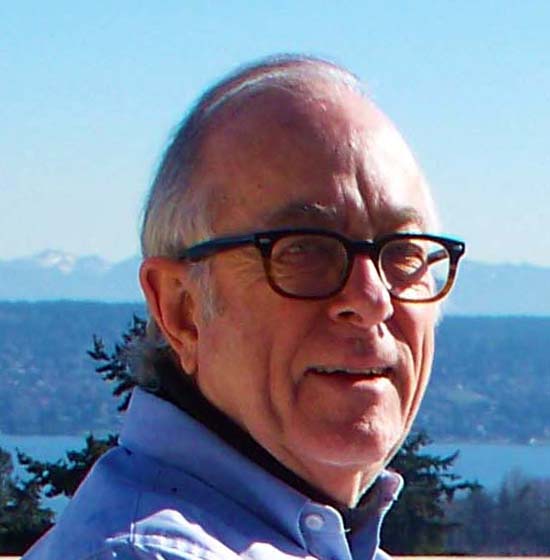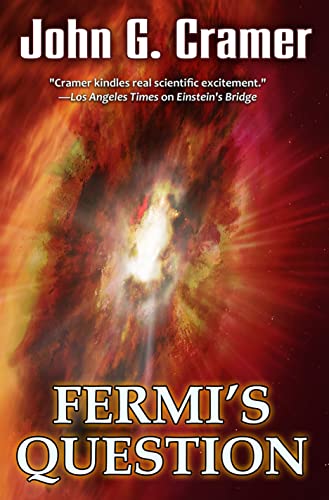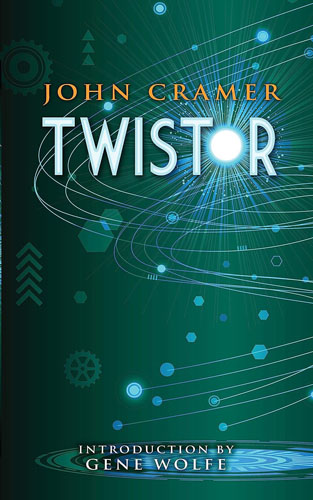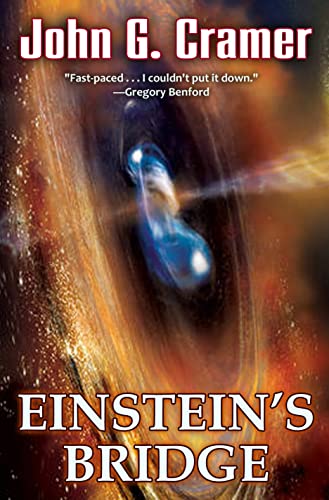A
Novel of Hard Science Fiction, Sequel to Einstein's Bridge
by John
Cramer
Published: 6/6/2023
Baen Books Ebook: $6.99
It has been 15 years
since the events of Einsteinís Bridge. George and Alice
Griffin and theorist Roger Coulton have established the Iris Foundation, a
powerful island-isolated research organization tasked with exploiting the
technologies learned from the Makers, re-learning Maker techniques for
creating wormholes, reestablishing contact with the Makers, and protecting
Earth from Hive invasions. Sparked by a new idea from Roger, Iris
researchers finally master wormhole technology and use accelerated wormholes
to create Fermi Station, an outpost in the Oort Cloud where Hive-attracting
SSC-type proton-proton collisions can be produced..
Contact is
established with the Makers and the Centaurs, a justice-seeking robotic
civilization in our galaxy that uses accelerated wormhole probes for
exploration. The triple alliance mounts a three-pronged attack on the Hive
world, destroying the Hive and one of its colonies. A second Hive colony
cannot be located and could pose a future problem. The Iris Foundation
launches an armada of accelerated wormholes to probe nearby star systems with
planets. By good fortune, they are able to establishe a colonization
base on Orca, an Earth-like moon orbiting gas-giant planet Bowhead in the Tau
Ceti system.
Mankind has reached the
stars.
Tags: alien
contact,
machine civilization, hard
science fiction, wormhole
physics, accelerated wormhole probes, extra-solar planetary exploration,
inter-universe warfare.
Order from
Baen Books at: https://www.baen.com/fermi-s-question.html
.
Order from Amazon at: https://www.amazon.com/Fermis-Question-John-Cramer-ebook/dp/B0BTTTD35Q
.
Publication History:
-
Fermi's Question, Baen
Books, (2023) eBook, eISBN: 978-1-62579-926-5; List price $6.99
Comments by the Author:
Since starting graduate
school at Rice University in Fall-1957, I have been actively
engaged in physics basic research and teaching for about five decades. In January-2010 I retired from
the University of Washington's physics teaching faculty and became
Emeritus Professor of Physics. My experimental research work in
ultra-relativistic heavy ion physics with the STAR Collaboration at Brookhaven
ended in 2015 when our DOE funding ended due to my retirement. During my
career as a physicist, my SF
writing has been rather sporadic. I wrote Twistor as an
outlet from the stress of accelerator-building in the 1980s, and I revised and
completed Einstein's
Bridge while I was on sabbatical in Munich and CERN in the
1990s.
My UW retirement made
extra time available. To use that time productively, I set four goals for myself: (1)
finally write a complete the book I had been planning for years, describing my paradigm-breaking transactional
interpretation of quantum mechanics, (2) pursue a fascinating quantum optics experiment in
which nonlocally switchable interference patterns, depending on measurement
type, seemed to offer the possibility of faster-than-light and back-in-time
nonlocal communication, (3) perform a theoretical calculation that used the
advanced wave of the transactional approach to directly
describe the mysterious quantum process of wave function collapse, which must be "put in by
hand" without any mechanism or explanation in standard quantum mechanics, and
(4) write two more
hard SF novels with the working titles Fermi's Question (FQ) and Hawking's
Warning (HW), both of which set in the multi-universe of my 2nd hard SF novel Einstein's Bridge
(EB), thereby making EB the first book of a trilogy,
Goal 1 resulted in
my January-2016 hardcover publication from Springer of The
Quantum Handshake - Entanglement, Nonlocality and Transactions (TQH),
my new book that describes in detail my transactional interpretation of quantum mechanics and
then applies it to
gain detailed understanding of ~35
otherwise mysterious or paradoxical quantum optics experiments (double-slit,
Schrödinger's cat, Wheeler's delayed choice, EPR, quantum eraser, Black
Hole information, ...).
Goal 2 led to three frustrating years
of experimental effort in the basement Laser Lab of the UW Physics-Astronomy Building.
Ultimately, however, understanding was achieved and described
in a 2014 paper entitled "An
Inquiry into the Possibility of Nonlocal Quantum Communication" and in Chapter 7 of TQH. The bottom line
is that Nature neatly blocks all such nonlocal communication. She does it
Herself, but She won't let us participate.
Goal 3 was achieved by working with
retired CalTech Professor Carver
Mead. We completed the new calculation, produced lots of lovely
figures with Mathematica, and demonstrated in detail what is going
on when a wave function collapses, at least in the case of an excited hydrogen atom
emitting a photon that is received and excites another hydrogen atom. In
the work, we fixed a problem that plagued
Schrödinger and his followers, and we learned a lot about the way the universe works. The
long paper describing our results, entitled "Symmetry,
Transactions, and the Mechanism of Wave Function Collapse", was
published in the August-2020 issue of the online open-access journal Symmetry.
Goal 4 produced this novel, but it has a checkered history. David
G. Hartwell of Tor Books, perhaps the leading editor of hard
SF, was the editor of my first novel Twistor and the later became
the spouse of my
daughter Kathryn Cramer.
In the summer of 2015, at our orchard in Westport, NY, I wrote a first chapters
and detailed chapter-by-chapter outlines of FQ and HW, and I offered these to
David for Tor Books publication. After he consulted Tor-founder Tom
Doherty, we arrived at an advance amount and signed a contract for publishing FQ
and for re-publishing of EB, with an option for later purchasing and publishing HW. I
immediately started transforming outline to real chapters of Fermi's Question, and I had finished a few
of these by January-2016. Then I received the shocking news that David,
carrying a glass-front bookcase section upstairs, had fallen backwards down the
narrow basement stairway of our jointly-owned orchard house in Westport,
NY. He had landed on his head, never regained consciousness, and was pronounced dead in
Plattsburg, NY two days later.
At David's funeral a few weeks later, I was assured by senior Tor editors that FQ was still on track, that I
should select a new Tor editor, and that things would move forward from
there. I did so, and by the end of 2016 I had completed a ~60,000 word
first draft of FQ and
sent it to my new editor. From my experience with David, I was expecting
significant feedback, including suggestions for cuts, modifications, and/or enlargements. Instead, my new editor just commented that FQ read like a
police procedural, except with wormhole physics instead of finding a killer.
He
also said
that in its present form it wasn't acceptable to Tor because it was too short and wasn't
finished. I explained that as the middle book of a trilogy, so the plot
line wasn't
supposed to be finished, and the finish would come with HW, which I hadn't
written yet. After some heated negotiations, it was decided that the two
outlined books would have to be combined into one, and that the projected EB trilogy would become a duology.
On December 2, 2017 I finished a full draft
of the combined EB manuscript and sent it to my Tor editor. Months passed, and I heard
nothing from him. Then, in mid-2018, I received a message conveying the
information that (1)
Tor was canceling my contract, (2) I could keep the half-advance I had
already received, and (3) my editor was being fired by Tor Books. I won't
comment further on this situation, except to say that the New York publishing
industry has always been a scene of great drama and chaos, and that David's death must
have resulted in a particularly chaotic situation at Tor. I gather that
they have turned away from hard SF.
So I had to undertake
the task of finding a new publisher for my orphaned book(s). The problem
was that, since FQ was a sequel, it would be necessary to re-publish EB,
(originally published by Avon/Harper-Collins and now out of print) as well as FQ.
That double publishing commitment was more than a number of the publishers
I approached were willing to make. Also about then the Covid pandemic and
shutdown came along to further complicate things.
Fortunately, Baen Editor Toni Weisskopf stepped in to provide a home for my two
novels at Baen Books. The double EB + FQ publication was made less of a
problem because they are published as Ebooks only. And so, about five
years after I had expected FQ, the second novel of the projected EB trilogy to appear, the
combined FQ novel and its EB prequel are available for purchase.
What about now writing a sequel to FQ? Admittedly, I have completed all of
my listed
retirement goals (above), and I did leave a few hooks for a sequel-sequel.
One of the Hive's conquest colonies is still hidden in some unknown bubble
universe and poses a potential danger to Earth humans and friends. The
human colony on the Earth-like moon Orca in the Tau Ceti system is just getting
started and is like the Wild West. The new accelerated-wormhole technology effectively opens the galaxy
to more human exploration, and more of it is certainly needed. And finally the
Elder Race that seems to inhabit Tabby's Star has already paid humans one
virtual visit
and may not be done with us. So there are some possibilities ...
Writing another hard SF novel would be a lot of work, and so far the rewards have been
rather slim. All I can say is: I'm thinking about it.
John G.
Cramer
Seattle, Washington
07/04/2023
This page was created by John G. Cramer
on 7/10/96 and revised on 07/04/2023


![[Home]](./About Einstein's Bridge_files/home.gif)


![[Mailbox]](G2/flagup.gif)